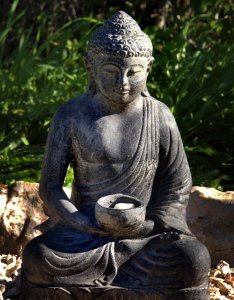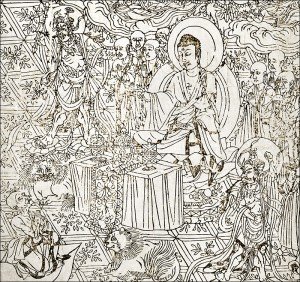About 550 BC a man of northern India called Gautama achieved liberation or enlightenment after 7 days of intensive meditation. It was through this achievement that he was called a Buddha, an enlightened one. Born and brought up in a royal family the prince Siddhartha Gautama had left his palace including wife and son to look for the real thing. He followed ascetics and lived with hermits, studied various yogic practices but was not able to overcome his inner duality; every answer he found brought more questions.
 Finally he engaged in a very severe fasting. It is said that he was only eating about 1 grain of rice a day. About to die he was rescued by a young woman, called Sunyata, who offered him a bowl of milk. After this experience Gautama knew that it was neither through protection and wealth nor through mortification and physical neglect that the truth could be realized.
Finally he engaged in a very severe fasting. It is said that he was only eating about 1 grain of rice a day. About to die he was rescued by a young woman, called Sunyata, who offered him a bowl of milk. After this experience Gautama knew that it was neither through protection and wealth nor through mortification and physical neglect that the truth could be realized.
Seeing this paradox clearly Gautama placed himself under a tree and sat in deep meditation. He vowed not to rise from his seat until having fully resolved the deep quest he had about his existence. On the morning of the seventh day, seeing the morning star rising above the horizon he had an experience of profound oneness and understanding. Being free from the perpeteous rising and vanishing of thoughts and emotions, being free from the circle of birth and death a Buddha was born into this world.
2500 years after the Buddha his teachings are still flourishing in the east and also in the west. One of the different schools still existing into our time is Zen. The Zen what we practice today is exactly the same practice what the Buddha went through long time ago. The key points are:
- an upright, immobile, relaxed posture, free from tensions caused by desires to escape or to achieve something . . . . .
- A calm and regular deep breathing, which focuses and calms the mind.
- Being undisturbed and present in body and mind creates an atmosphere of clarity and joy. Our thoughts and emotions can be seen as what they really are : clouds moving on an endless vast sky, reflections in a mirror.

